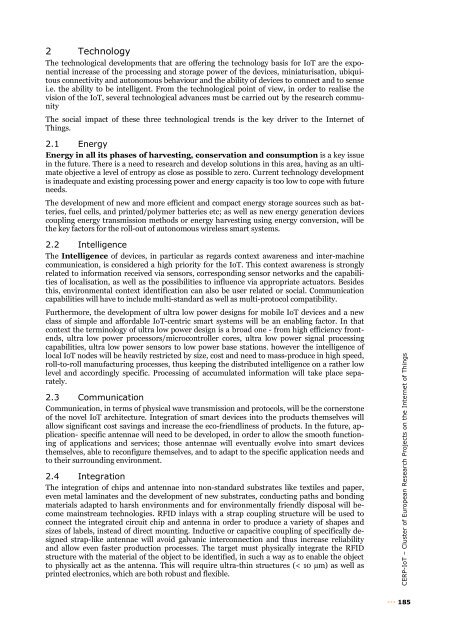Vision and Challenges for Realising the Internet of Things
Vision and Challenges for Realising the Internet of Things
Vision and Challenges for Realising the Internet of Things
Create successful ePaper yourself
Turn your PDF publications into a flip-book with our unique Google optimized e-Paper software.
2 Technology<br />
The technological developments that are <strong>of</strong>fering <strong>the</strong> technology basis <strong>for</strong> IoT are <strong>the</strong> exponential<br />
increase <strong>of</strong> <strong>the</strong> processing <strong>and</strong> storage power <strong>of</strong> <strong>the</strong> devices, miniaturisation, ubiquitous<br />
connectivity <strong>and</strong> autonomous behaviour <strong>and</strong> <strong>the</strong> ability <strong>of</strong> devices to connect <strong>and</strong> to sense<br />
i.e. <strong>the</strong> ability to be intelligent. From <strong>the</strong> technological point <strong>of</strong> view, in order to realise <strong>the</strong><br />
vision <strong>of</strong> <strong>the</strong> IoT, several technological advances must be carried out by <strong>the</strong> research community<br />
The social impact <strong>of</strong> <strong>the</strong>se three technological trends is <strong>the</strong> key driver to <strong>the</strong> <strong>Internet</strong> <strong>of</strong><br />
<strong>Things</strong>.<br />
2.1 Energy<br />
Energy in all its phases <strong>of</strong> harvesting, conservation <strong>and</strong> consumption is a key issue<br />
in <strong>the</strong> future. There is a need to research <strong>and</strong> develop solutions in this area, having as an ultimate<br />
objective a level <strong>of</strong> entropy as close as possible to zero. Current technology development<br />
is inadequate <strong>and</strong> existing processing power <strong>and</strong> energy capacity is too low to cope with future<br />
needs.<br />
The development <strong>of</strong> new <strong>and</strong> more efficient <strong>and</strong> compact energy storage sources such as batteries,<br />
fuel cells, <strong>and</strong> printed/polymer batteries etc; as well as new energy generation devices<br />
coupling energy transmission methods or energy harvesting using energy conversion, will be<br />
<strong>the</strong> key factors <strong>for</strong> <strong>the</strong> roll-out <strong>of</strong> autonomous wireless smart systems.<br />
2.2 Intelligence<br />
The Intelligence <strong>of</strong> devices, in particular as regards context awareness <strong>and</strong> inter-machine<br />
communication, is considered a high priority <strong>for</strong> <strong>the</strong> IoT. This context awareness is strongly<br />
related to in<strong>for</strong>mation received via sensors, corresponding sensor networks <strong>and</strong> <strong>the</strong> capabilities<br />
<strong>of</strong> localisation, as well as <strong>the</strong> possibilities to influence via appropriate actuators. Besides<br />
this, environmental context identification can also be user related or social. Communication<br />
capabilities will have to include multi-st<strong>and</strong>ard as well as multi-protocol compatibility.<br />
Fur<strong>the</strong>rmore, <strong>the</strong> development <strong>of</strong> ultra low power designs <strong>for</strong> mobile IoT devices <strong>and</strong> a new<br />
class <strong>of</strong> simple <strong>and</strong> af<strong>for</strong>dable IoT-centric smart systems will be an enabling factor. In that<br />
context <strong>the</strong> terminology <strong>of</strong> ultra low power design is a broad one - from high efficiency frontends,<br />
ultra low power processors/microcontroller cores, ultra low power signal processing<br />
capabilities, ultra low power sensors to low power base stations. however <strong>the</strong> intelligence <strong>of</strong><br />
local IoT nodes will be heavily restricted by size, cost <strong>and</strong> need to mass-produce in high speed,<br />
roll-to-roll manufacturing processes, thus keeping <strong>the</strong> distributed intelligence on a ra<strong>the</strong>r low<br />
level <strong>and</strong> accordingly specific. Processing <strong>of</strong> accumulated in<strong>for</strong>mation will take place separately.<br />
2.3 Communication<br />
Communication, in terms <strong>of</strong> physical wave transmission <strong>and</strong> protocols, will be <strong>the</strong> cornerstone<br />
<strong>of</strong> <strong>the</strong> novel IoT architecture. Integration <strong>of</strong> smart devices into <strong>the</strong> products <strong>the</strong>mselves will<br />
allow significant cost savings <strong>and</strong> increase <strong>the</strong> eco-friendliness <strong>of</strong> products. In <strong>the</strong> future, application-<br />
specific antennae will need to be developed, in order to allow <strong>the</strong> smooth functioning<br />
<strong>of</strong> applications <strong>and</strong> services; those antennae will eventually evolve into smart devices<br />
<strong>the</strong>mselves, able to reconfigure <strong>the</strong>mselves, <strong>and</strong> to adapt to <strong>the</strong> specific application needs <strong>and</strong><br />
to <strong>the</strong>ir surrounding environment.<br />
2.4 Integration<br />
The integration <strong>of</strong> chips <strong>and</strong> antennae into non-st<strong>and</strong>ard substrates like textiles <strong>and</strong> paper,<br />
even metal laminates <strong>and</strong> <strong>the</strong> development <strong>of</strong> new substrates, conducting paths <strong>and</strong> bonding<br />
materials adapted to harsh environments <strong>and</strong> <strong>for</strong> environmentally friendly disposal will become<br />
mainstream technologies. RFID inlays with a strap coupling structure will be used to<br />
connect <strong>the</strong> integrated circuit chip <strong>and</strong> antenna in order to produce a variety <strong>of</strong> shapes <strong>and</strong><br />
sizes <strong>of</strong> labels, instead <strong>of</strong> direct mounting. Inductive or capacitive coupling <strong>of</strong> specifically designed<br />
strap-like antennae will avoid galvanic interconnection <strong>and</strong> thus increase reliability<br />
<strong>and</strong> allow even faster production processes. The target must physically integrate <strong>the</strong> RFID<br />
structure with <strong>the</strong> material <strong>of</strong> <strong>the</strong> object to be identified, in such a way as to enable <strong>the</strong> object<br />
to physically act as <strong>the</strong> antenna. This will require ultra-thin structures (< 10 μm) as well as<br />
printed electronics, which are both robust <strong>and</strong> flexible.<br />
CERP-IoT – Cluster <strong>of</strong> European Research Projects on <strong>the</strong> <strong>Internet</strong> <strong>of</strong> <strong>Things</strong><br />
185
















